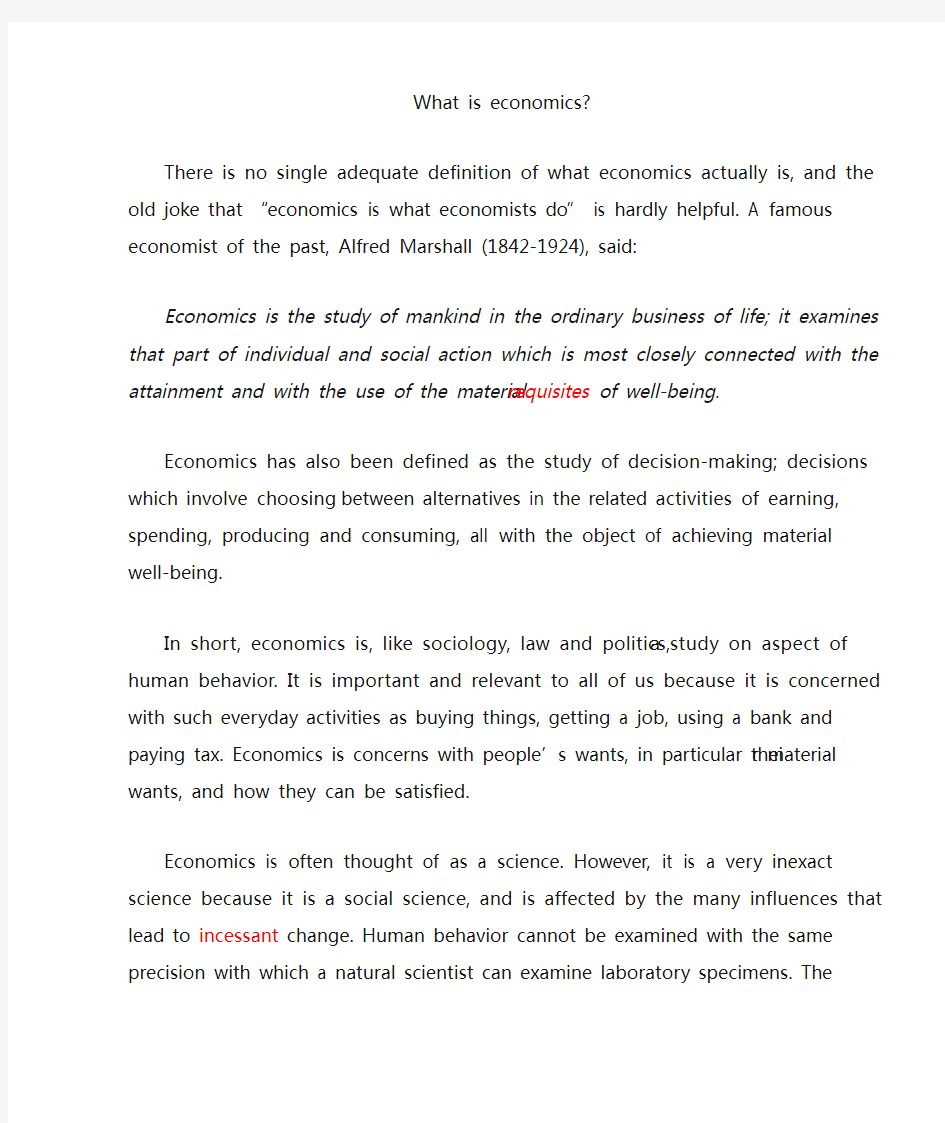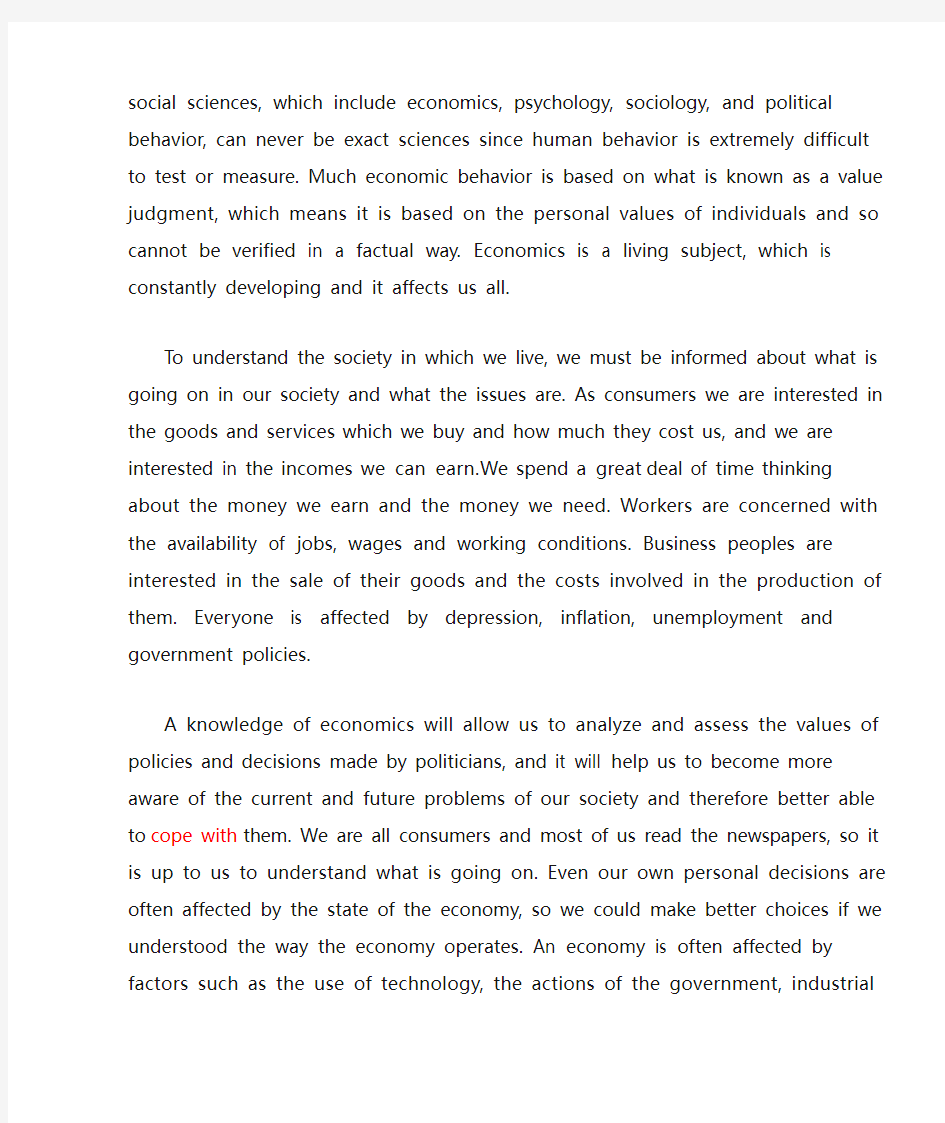What is economics


What is economics?
There is no single adequate definition of what economics actually is, and the old joke that “economics is what economists do” is hardly helpful. A famous economist of the past, Alfred Marshall (1842-1924), said:
Economics is the study of mankind in the ordinary business of
life; it examines that part of individual and social action which
is most closely connected with the attainment and with the use
of the material requisites of well-being.
Economics has also been defined as the study of decision-making; decisions which involve choosing between alternatives in the related activities of earning, spending, producing and consuming, all with the object of achieving material well-being.
In short, economics is, like sociology, law and politics, a study on aspect of human behavior. It is important and relevant to all of us because it is concerned with such everyday activities as buying things, getting a job, using a bank and paying tax. Economics is concerns with people’s wants, in particular the ir material wants, and how they can be satisfied.
Economics is often thought of as a science. However, it is a very inexact science because it is a social science, and is affected by the
many influences that lead to incessant change. Human behavior cannot be examined with the same precision with which a natural scientist can examine laboratory specimens. The social sciences, which include economics, psychology, sociology, and political behavior, can never be exact sciences since human behavior is extremely difficult to test or measure. Much economic behavior is based on what is known as a value judgment, which means it is based on the personal values of individuals and so cannot be verified in a factual way. Economics is a living subject, which is constantly developing and it affects us all.
To understand the society in which we live, we must be informed about what is going on in our society and what the issues are. As consumers we are interested in the goods and services which we buy and how much they cost us, and we are interested in the incomes we can earn. We spend a great deal of time thinking about the money we earn and the money we need. Workers are concerned with the availability of jobs, wages and working conditions. Business peoples are interested in the sale of their goods and the costs involved in the production of them. Everyone is affected by depression, inflation, unemployment and government policies.
A knowledge of economics will allow us to analyze and assess the values of policies and decisions made by politicians, and it will help us to become more aware of the current and future problems of our society
and therefore better able to cope with them. We are all consumers and most of us read the newspapers, so it is up to us to understand what is going on. Even our own personal decisions are often affected by the state of the economy, so we could make better choices if we understood the way the economy operates. An economy is often affected by factors such as the use of technology, the actions of the government, industrial relations, and overseas trade. All of these influences result in constant change. Prices seem to rise constantly. Some jobs are no longer available, while new types of jobs appear. Changes in employment and prices affect almost everyone.
Employment and the types of jobs available are all part of the economic pattern. Some jobs may involve extreme specialization, such as making just a small part of something; others demand professional skills. All of these activities enable us to have a variety of goods and services, but while economic activities satisfy our wants, there are also economic problems to be faced. The economic system is made up of human beings and so human behavior is crucial to the system. The principles and motives form which people act are not necessarily economic in origin, and are often based on non-economic values. Differing values and social forces have led to countries developing different economic systems, but all countries face the same economic problems—such as whether they are producing the right things and by
the best methods, how wants are to be satisfied, and whose wants are to be satisfied.
Economics is a study of living and working in society; but not all societies behave in the same way.
In order to produce the things people want there must be some kind of organization. An economic system is made up of the collection of relationships, customs, institutions, laws and arrangements that are combined to satisfy the economic wants of the community—to determine what and how production takes place, and who receives the output. Naturally it depends on the participation of the members of the community. An economic system is not just an abstraction; it is the real world.
In one sense the economic system of a society does grow or, rather, develop, because the type of system a country has depended on its historical background and its political forces. A nation’s history and political tradition are important in shaping its economic goals and methods, and its basic economic institutions. The value and beliefs held by the members of the society are also influential.
The job of an economic system is to form a framework of organization which enables choices and decisions to be made on how to satisfy the wants of the community. The way it does this depends largely on the type of society. In the USA there is still a belief in the value of free
enterprise and the ability of individuals to succeed if they work hard enough. In some countries, such as England and possibly Sweden, there is a belief in the welfare state, that it is up to the government to look after the citizens from the cradle to the grave, although there have been criticisms of this approach because of cost. Countries like Australia seem to represent mixture of both these attitudes.
National characteristics and belief systems have led to many differences between economic systems. It cannot by say that just because two countries have the same political governments, they will run their economics in the same way. It is not easy to compare one economy with another and say that one is better or worse - there is too much diversity, and adequate measurement is impossible. One can, however, say that the standard of living is better in one economy than in another. Or one can compare such things as the level of unemployment or the stability of prices. But these single measures cannot show a true or complete picture of an econom y.
Sunk Costs
Although an opportunity cost is often hidden,it should be taken into account when making economic decisions. Just the opposite is true of a sunk cost: an expenditure that has been made and cannot be recovered.
A sunk cost is usually visible, but after it has been incurred, it should always be ignored when making future economic decisions.
Because a sunk cost cannot be recovered, it should not influence the firm's decisions. For example, consider the purchase of specialized equipment designed for a plant. Suppose the equipment can be used to do only what is was originally designed for and cannot be converted for alternative use. The expenditure on this equipment is a sunk cost. Because it has no alternative use, its opportunity cost is zero. Thus it should not be included as part of the firm's costs. The decision to buy this equipment may have been good or bad. It doesn't matter. It's water under the bridge and shouldn't affect current decisions.
What if, instead, the equipment could be put to other use, or could be sold or rented to another firm? In that case its use would involve an economic cost - namely, the opportunity cost of using it rather than selling or renting it to another firm.
Now consider a prospective sunk cost. Suppose, for example, that the firm has not yet bought the specialized equipment but is merely considering whether to do so. A prospective sunk cost is an investment. Here the firm must decide whether that investment in specialized equipment is economical - i.e., whether it will lead to a flow of revenues large enough to justify its cost.
感受现代科技
感受现代科技 【学习目标】 1、知识:感受现代科技给人类生活带来的新变化,认识科技与生活,科技发展与社会发展的关系,懂得“科学技术是第一生产力”的道理。 2、能力与情感:感悟现代科技的神奇与力量,理解科技是社会发展的强大推力,激发学生 对科技重要性的认识,增强学生对科学的兴趣,培养学生热爱科学的精神。 3、过程与方法:依据教学内容和学生的认识规律设置了“课前预习”、“课堂助学”、“课堂巩固”、“课后拓学”、“教学反思”五个模块的教学整合,运用多媒体等教学手段,采用自主体验、 探究活动、案例情境等方法来完成教学目标。 【学习重点、难点】 领略现代科技的神奇与力量,理解“科技是第一生产力”。 【学习过程】 一、预习初探: (一)快快行动,书外的知识真有趣: 1、生活体验:观察生活,请你说说我们身边有哪些科技产品?例举实例说说这些科技产品给我们的生活带来哪些新变化? 2、想象天地:展现你的想象天份,想象你准备发明一样科技产品,使你的未来生活更美好。 3、图片收集:上网收集有关科技产品的图片,准备创办科技小展览,领略现代科技的神 奇与力量。 (二)阅读课本,书本的知识真寻味: 4、我们现在的生活与科技________________。丰足的衣食,舒适的住行,千百年来一直是人类_________________。 5、科学技术是________________的强大推力,是________生产力。______________已成为当代经济发展的火车头。 6、________________是人类文明的标志。科学技术的进步为人类创造了巨大的 ______________和_________________。
感受现代科技
第十四课感受现代科技 项目一现代科技在身边 教师寄语:今日沟通于昔日之最大差异:在于科技的介入,已超越时间、空间,甚至权利与阶级的围墙。 学习目标: ●情感态度价值观:感受现代科技发展带来的新变化,培养学生热爱科学的情感和品质。 ●能力:培养学生观察、收集、整理、归纳信息的能力。 ●知识:了解科技对社会发展具有推动作用,理解科学技术是第一生产力。 重难点:科技是社会发展的强大推动力 学习过程: 一、课前预习(提前预习课本,顺便做以下小题,相信你能完成!) 1.我们现在的生活与科技_________。 2.___________________是第一生产力。 3._______________已成为当代经济发展的火车头。 4.科学技术是_______________的标志。 5.科技是社会发展的______________。 二、合作探究,共同进步(合作有助于提高学习效率,要努力哦!) 知识点一:现代科技给生活带来新变化 1:(见教材P58页-59页)图片1:液晶彩色电视图片2:利用网络学习 图片3:山里人用上了手机图片4:磁悬浮列车 说一说:观察生活,列举实例,说说现代科技给我们的生活带来哪些新的变化? 2:阅读教材(P59页教材正文),说说现代科技的发展给人类的生活产生了怎样的影响?(学生讨论交流) 。3:(见教材P59页-60页)想象和推测一下,随着科技的发展,5年、10年、20年、50年后人们的生活可能是怎样的? 。 知识点二:科技——社会发展的强大推力 1:(见教材P61页),材料中的数字变化说明了什么?(学生讨论交流) 上述材料中的数字变化说明:“”。 2:为什么说“科学技术是第一生产力”? ① ② 实践证明:高新技术及其产业已经成为当代经济发展的火车头。 3:(见教材P62页)说一说:网络学校的发展将会给人们的学习方式带来了哪些变化? 4、①科学技术的进步使精神文明建设有了新的载体. 说一说:在思想文化传播的载体方面,你知道有哪些新的传播手段呢? ②科学技术的进步丰富了人们的 . 5、科学技术的进步为人类创造了巨大的财富和财富 三、课堂小结 通过学习我学会:
小学三年级Whatcolorisit教案
Whatcolorisit教学设计 一、Teaching Content: Whatcolorisit 二、Teachingobjectives: 1、Knowledge objectives 学会用英语表达事物的颜色,掌握相关的单词: red\yellow\blue\green\pink\purple\orange\black\white 和句型Whatcolorisit--It’s…,并能综合运用新、旧知识组织对话完成一定交际任务。 2、Ability objectives:培养学生的观察力、想象力、动手操作能力,提高学生感受美、欣赏美的水平,发展学生综合运用语言的能力。 3、Emotional objectives 激发学生学习英语的兴趣,调动学习积极性,引导学生积极与他人合作,在活动中培养学生的协作精神和竞争意识。 三、Teaching key points 创设语言情景,使学生正确理解和运用所学知识表达事物颜色。四、Teaching difficult points 激发学生的求知欲,创设各种真实或接近真实的语言环境,让学生体验参与,主动学习事物颜色的表达法。
五、Teaching material (一)、材料准备 1、“red、yellow、blue、green、pink、purple、orange、black、white”单词卡片及“WhatcolorisitIt’s…”句型卡片; 3、彩虹、熊猫、哆啦A梦、HelloKitty、葡萄等彩笔画若干及一些带颜色的实物; 4、写有颜色的名牌; 5、比赛的纸 6、歌曲ColorSong录音 (二)学情分析 三年级学生的年龄在九、十岁左右,生性活泼好动,喜欢直观形象思维,对游戏、竞赛、画画特别感兴趣。学生学英语不久,有可能说的不好,有的还不敢说,课堂上要以表扬为主,注重培养学习英语的兴趣,鼓励他们大胆说、积极做、认真唱! 六、Teaching Procedure 1、T:Goodmorning,boysand’m very happy to have lesson with you,are you happy too
走进都市农业 感受现代科技
走进都市农业感受现代科技 --"大东农业观光园"基地实践活动 设计者:大兴区第九小学窦雪征 指导教师:大兴区教师进修学校柏东河 ( 2008-05-27 13:40:19 ) 一、环境分析 我国是个农业大国。当前,在农业科技领域,中国不断缩小与发达国家的差距,农业科技部门在生物技术、高新技术、基础研究方面均取得较大进展,植物细胞和组织培养、花药培养、单倍体育种及其应用研究处于国际先进地位。但是,作为国家希望的小学生却对我国农业的了解知之甚少,甚至有的学生只认识餐桌上的蔬菜,田地里面的蔬菜就不认识了。而且由于社会环境的影响,学生对于农业生产的认识非常极端,认为农业生产只是辛苦的体力劳动,对其间蕴含的高科技文化知识基本不了解。 大兴区作为北京市的一个远郊区县,拥有着得天独厚的农业教育资源,在我们的身边就有向"大东农业观光园"这样的一个很好的农业教育基地。在大东农业观光园里面充分体现了现代农业。它目前拥有现代化日光温室34个,塑料大棚34个,露地80亩,为观光采摘、实验、示范、生产提供了场所。农业观光园里引进福建有机茶叶树,通过土壤改质能使其在北方正常生长;蔬菜嫁接的试验技术;大棚中的科学技术,如:所有地面具备节能、日光温室跨度大、内设供热、微喷、保湿、补光等多项功能;另外园区内设有科普知识长廊,为学生了解我国农业的历史文化和发展,创造了很好的条件。此基地实践活动适合小学高年级学生,他们可以在基地里面,进行参观、体验、学习了解高科技农业技术。通过基地的实践活动,可以增长学生现代农业知识,提高劳动能力,体验劳作的艰辛,培养学生良好的道德品质。可以很好的促进学生学习方式的变革,使学生直接从事实践性主题活动,实现学生自主学习和直接体验为主的学习方式,从而不
